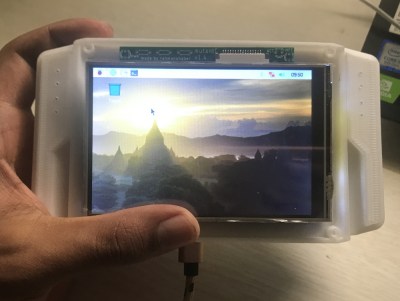Keywords: digital artefacts, raspberry PI zero, upcycling, make-your-own-device, creativity, touchless man-machine interaction, zone of proximal development, electronic ink, algorithmic drum circle
Session 2 - Art & Artefact
/
Before doing the theory let's test our paper airplanes!Session 4 - Material & Components
/
Let's start making it real.mutantC
/

https://mutantc.gitlab.io/index.html
Over the years we’ve seen the Raspberry Pi crammed into almost any piece of hardware you can think of. Frankly, seeing what kind of unusual consumer gadget you can shoehorn a Pi into has become something of a meme in our circles. But the thing we see considerably less of are custom designed practical enclosures which actually play to the Pi’s strengths. Which is a shame, because as the MutantC created by [rahmanshaber] shows, there’s some incredible untapped potential there.
 The
MutantC features a QWERTY keyboard and sliding display, and seems more
than a little inspired by early smartphone designs. You know, how they
were before Apple came in and managed to convince every other
manufacturer that there was no future for mobile devices with hardware
keyboards. Unfortunately, hacking sessions will need to remain tethered
as there’s currently no battery in the device. Though this is something
[rahmanshaber] says he’s actively working on.
The
MutantC features a QWERTY keyboard and sliding display, and seems more
than a little inspired by early smartphone designs. You know, how they
were before Apple came in and managed to convince every other
manufacturer that there was no future for mobile devices with hardware
keyboards. Unfortunately, hacking sessions will need to remain tethered
as there’s currently no battery in the device. Though this is something
[rahmanshaber] says he’s actively working on.
The custom PCB in the MutantC will work with either the Pi Zero or the full size variant, but [rahmanshaber] warns that the latest and greatest Pi 4 isn’t supported due to concerns about overheating. Beyond the Pi the parts list is pretty short, and mainly boils down to the 3D printed enclosure and the components required for the QWERTY board: 43 tactile switches and a SparkFun Pro Micro. Everything is open source, so you can have your own boards run off, print your case, and you’ll be well on the way to reliving those two-way pager glory days.
We’re excited to see where such a well documented open source project like MutantC goes from here. While the lack of an internal battery might be a show stopper for some applications, we think the overall form factor here is fantastic. Combined with the knowledge [Brian Benchoff] collected in his quest to perfect the small-scale keyboard, you’d have something very close to the mythical mobile Linux device that hackers have been dreaming of.
Keyboards:
https://hackaday.io/project/158454-mini-piqwerty-usb-keyboard
https://hackaday.com/2019/04/23/reaction-video-build-your-own-custom-fortnite-controller-for-a-raspberry-pi/
Session 6 :: Format
/
- In what domains of human activity do we speak about formats ?
- In these disciplines, what kinds of formats do we know ?
- Can we imagine other types of formats ? What are their advantages ? What are their disadvantages ?
- What kinds of formats should we use ?
Overall Entwurf
/
| WiSe 2018/2019 | Bootstrapping & exploring |
| SoSe 2019 | Playing, specifying, defining |
| WiSe 2019/2020 | E-paper |
| SoSe 2020 | Machine learning, speech technologies, handwriting recognition |
| WiSe 2020/2021 | Testing & optimizing |
| SoSe 2021 | Deploying |
WiSe 2021/2022 |
??? |
Contacts
/
Prof. Dr. Dr. Daniel Hromada- daniel at udk-berlin.de
- Room 313, Medienhaus
- Sprechstunden 12:30 - 13:30
Tutors & SHK
- Astrid Kraniger a.kraniger@udk-berlin.de
- Nikoloz Kapanadze nikoloz-kapanadze@medienhaus.udk-berlin.de
MODEA #2 Program
/
| Date | Topic |
|---|---|
| 11.4 | Introduction |
| 18.4 | Art & Artefacts |
| 25.4 | Tools & instruments |
| 2.5 | Material |
| 9.5 | Modules and components |
| 16.5 | Making the Itty Bitty Beat Box |
| 23.5 | ECDF visit - Wilhelmstrasse 67 |
| 30.5 | NO COURSE (Christihimmelfahrt) |
| 6.6 | Format |
| 13.6 | Shell |
| 20.6 | Berlin Open Lab - Einstein Ufer UdK |
| 27.6 | Optimizing & testing |
| 4.7 | Goal |
Main communication channel
/
https://kastalia.medienhaus.udk-berlin.deMODEA #2 knot 4162 (i.e. https://kastalia.medienhaus.udk-berlin.de/4162 )
Validation
/
You'll get the signature only when actively participating on creating of an artefact which DOES something, e.g.- digital primer
- music instrument for algorithmic drum circle
- garden guardian
- digital primer
- light source
Main principles
/
- M.Y.O.D. :: Make Your Own device
- Upcycle !
- Explore the "adjacent possible".
- Uniqueness and not mass production.
Respeaker 2 Bluetooth Alsa stream
/
fibel.digital :: Phase 0 :: Permutations
/

MODEA #2 - Forum
/
This is the place where we should start communicating.Handouts
/
Some articles related to our course.Hardware
/
Phat Dat 1
Speaker Phat 1
Witty pi small 2 1 1
Witty pi big 2
Inky Phat 1
Grove Sound 1
Grove Ultrasound 1
Resistive HDMI 1
Raspi B+ 1 1
Phat Stack 1 1
Skywriter 1 1
E-ink 1
Capacitive HDMI 2
Strompi 1
Connecting a Bluetooth speaker to a Raspberry Pi Zero W running Raspian Stretch Lite
/
- sudo apt-get update && sudo apt-get dist-upgrade
- sudo apt-get install bluealsa
- sudo service bluealsa start
- Switch on your bluetooth device
- sudo bluetoothctl
- scan on
- pair XX:XX:XX:XX:XX:XX (replace the XXXXX with your device ID)
- trust XX:XX:XX:XX:XX:XX
- connect XX:XX:XX:XX:XX:XX
- exit
- aplay -D bluealsa:HCI=hci0,DEV=XX:XX:XX:XX:XX:XX,PROFILE=a2dp /usr/share/sounds/alsa/*
Session 5 :: Modules and components
/
- What is modularity ?
- What are modules ?
- What are advantages of a modular system ?
- What are disadvantages of a modular system ?
AE49SOSERundgang R311 Artefact List
/
Session 3 - Tools and Instruments
/
Nik - soldering ironDaniel - screwdriver
Anna - pen
Kohei - measure
Akif - Swiss knife